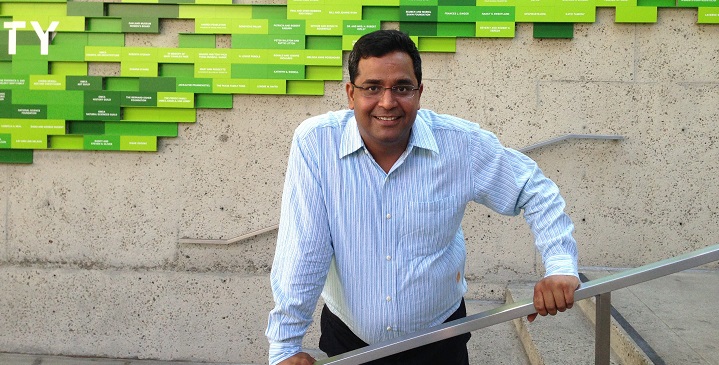
Inside Paytm’s mini-bank and its plans to go where banks don’t
By Meghna Rao for TechInAsia
Across the street from Paytm’s office in Noida is a man selling chai. The company’s signature blue and white sticker is pasted on the back wall of his store. I scan the accompanying QR code and transfer INR20 (US$0.30) from my wallet into his for a steaming hot cup.
He can use that money to top-up his phone, pay electricity bills, or buy things on Paytm’s ecommerce site. Once Paytm officially rolls out its payment bank – from a license granted by the Reserve Bank of India (RBI) that lets it hold up to INR100,000 (~US$1500) per customer – he’ll also have the option of earning interest on that money or taking it out in cash.
For the chaiwalla, earning interest is another incentive to encourage his customers to pay digitally with Paytm. The list of incentives is already long. Money is easier to track and it doesn’t require spending on hardware like card machines.
Sated with chai, I quiz Narendra Yadav, who is the general manager for strategic initiatives at Paytm. Is Paytm trying to replace banks?
It’s more about filling the gaps where payment is a problem, Narendra retorts. “Banks want customers. Customers want banking facilities. So why are there customers without banking facilities?”
Filling in the gaps
The payment bank is set to release in November – “if the RBI is okay with what we’ve created,” interjects Narendra – and will operate a current and savings account. Interest will be earned on money placed in the savings account. Its e-wallet service will continue to exist.
Interest rates haven’t been set, but founder Vijay Shekhar Sharma has stated in the past that they will match or exceed those of savings accounts in other banks. In India, fixed deposit rates usually range around 7.5 percent.
While earning interest is an opportunity for newcomers to learn more about the benefits that come with saving money, Narendra is quick to assert that Paytm will not involve itself in an interest war to attract customers.

Photo credit: Jon Collirt.
Unlike regular banks, payment banks can’t lend money. There’s not much that Paytm will get out of holding onto it – the company’s profits come from customers paying for things with its many services.
Narendra adds that encouraging the movement of money will answer some of the bigger questions that come with financial inclusion.
Bank account numbers have increased between 2011 and 2014, from 35 percent of the population to 53 percent – an increase of 175 million people – but 43 percent of those accounts were classified dormant in 2015.
It’s more than just about opening bank accounts, he explains. It’s getting people to spend money in useful ways.
Faster to sign people on
Why wouldn’t banks want to serve millions of untapped, new customers? Because it often doesn’t make financial sense for them, Narendra points out. Paytm has focused on innovating its technology to make it cheaper and faster to onboard individuals than it is for banks.
Procedures that verify customers, like KYC – know your customer – can take days of paperwork. In India, where there’s precious little data on millions of people, some don’t even have enough information to be verified. Paytm works with Aadhar, India’s new biometric identification system that identifies people with their fingerprints. Aadhar has e-KYC technology that lets Paytm verify customers instantly.
Paytm’s tech orientation also makes it more easier for it to adapt to customers demands than a regular bank. It’s also got a focus on user efficiency. “Our design is easy enough that people in new areas can learn how to use it quickly,” adds Narendra.
Moreover, in order to combat cash, Paytm is setting up a chain of business correspondents across the country. Account holders can deposit and withdraw cash physically at these locations, as well as go to them with questions.
For the merchants
Getting merchants along with the plan is arguably one of the most important factors behind Paytm’s success.
Online merchants – like Uber – pay a transaction discounting rate (TDR) of 1.99% when customers use its e-wallet or pay with a debit or credit card through Paytm’s payment gateway.
On the other hand, offline merchants – like my chaiwalla, whom I paid with the use of a QR code – don’t have to pay anything.
Just a few days ago, Paytm CEO Vijay Shekhar Sharma explained to MediaNama that more transactions happened offline than online in the month of August.
Narendra sees new venues for banking emerging from all this. “Imagine – Gupta Sweet House. He sells a certain amount of sweets a week and saves a chunk in this payment wallet. Once a lending institution starts seeing that, they might be comfortable lending to him.” In other words, the payment bank could have a cascading effect.
Challengers on all sides

Paytm founder Vijay Shekhar Sharma
Paytm’s got challengers on all sides. With its ecommerce site, it competes with Amazon India, Flipkart, and Snapdeal. When it comes to money, it puts up against rapidly evolving banks, including the newly released Unified Payments Interface that lets people transfer money with a single identifier. Top-ups and utility payments are combated by companies like Snapdeal-owned Freecharge.
It also has to deal with the nagging habit that refuses to leave – cash.
Narendra is confident that Paytm’s particular offerings will spur change. “We have 135 million customers completing 3 million transactions a day. We will have over 500 million customers by next year.”
Paytm is not the only one with a payment bank license. But a few of the others, including Tech Mahindra, have given up their licenses, stating that it’s hard to make money off the concept. Paytm, on the other hand, announced that it was pouring INR3.5 billion (US$52 million) into the initiative in July.
It’s certainly got enough cash to do that. Paytm has disclosed a few of its funding rounds, including one for US$680 million from Alibaba, as well as smaller cash infusions from the Chinese ecommerce site’s financial arm, Ant Financial. After recently announcing a US$60 million round from Mediatek’s Mountain Capital, Economic Times valued the firm at US$5 billion.
Its toughest competitor is one that can’t be solved with money or faster technology – purchasing power. In 2011, the World Bank estimated that 23.6 percent of the country’s population – 276 million people at the time – lived on less than US$1.25 a day.
Some hope comes from India’s fast growing economy. Is the payment bank making an entry at an appropriate time? It’s hard to tell. Diwali will certainly bring with it a moment of reckoning.
This post Inside Paytm’s mini-bank and its plans to go where banks don’t appeared first on Tech in Asia.





